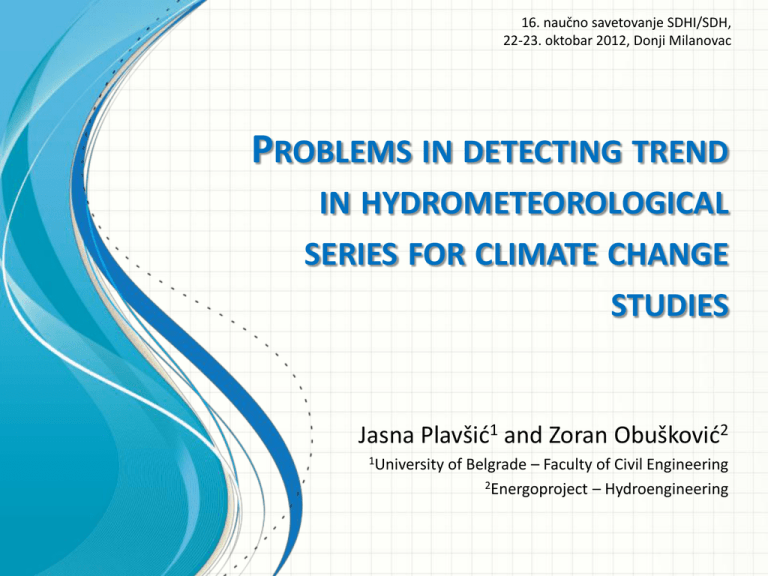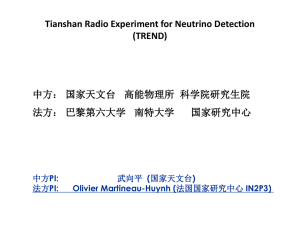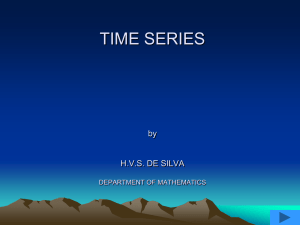Session 4 - Eionet Forum
advertisement

16. naučno savetovanje SDHI/SDH, 22-23. oktobar 2012, Donji Milanovac PROBLEMS IN DETECTING TREND IN HYDROMETEOROLOGICAL SERIES FOR CLIMATE CHANGE STUDIES Jasna Plavšić1 and Zoran Obušković2 1University of Belgrade – Faculty of Civil Engineering 2Energoproject – Hydroengineering Climate change • Global warming and increased concentrations of greenhouse gases Hansen et al, Proc. Natl. Acad. Sci., (2006) Copenhagen Diagnosis (2009) Climate change – we know Radionica - Klimatske Promene - 2010 Copenhagen Diagnosis (2009) www.slobodansimonovic.com Climate change – we know Radionica - Klimatske Promene - 2010 www.slobodansimonovic.com Climate change – we know Church and White , Geophysical Research Letters, (2006) Cazenave et al, Global and Planetary Change, (2009) Radionica - Klimatske Promene - 2010 www.slobodansimonovic.com Climate change impacts • Questions: – Change projections? – Impact on water resources? IPCC (2007) Impact of climate change on water resources Estimation of climate change impacts Future climate scenarios + hydrologic models Statistical trends fairly complicated approach; propagation of uncertainty simple calculations; but: How to prove presence of a trend? How to interpret the trend? Trend detection • Starting point: hydrometeorological series are considered stationary – stationarity is well defined and departures from stationary indicate changes • Trend detection vs. identification of non-stationarities – trend in mean is just one type of non-stationarities – false trend detection in time series where other nonstationarities are present • slow changes (long memory) can look like trend when observed in shorter periods – significance of trends can decrease in series with long memory and high serial correlation Practical aspects of trend analysis – choice of variables • Runoff – mean flows, floods, low flows – annual and monthly values – time of occurrence of annual maximum flood – ice start and end dates, number of days with ice • Precipitation – annual and monthly precipitation – daily precipitation annual maxima – number of rainy days – etc. Practical aspects of trend analysis – choice of stations • Trend analysis is valid if performed on adequate series – time series should be long enough for reliable statistical analysis • WMO recommends 30-year statistics for describing climate (eg. standard climatological period 1961-1990) • series used for analysis of change in climate should be much longer than 30 years – series should reflect natural flow regime with no human interventions within the basin – data from a station should be checked for accuracy and consistency (rating curves etc.) Tests for trend • Linear regression: X = a + bt 140 Lim/Brodarevo 120 Q (m3/s) 100 80 60 40 y = -0.1676x + 401.87 20 Qsrgod 0 1920 1930 1940 1950 1960 Linear (Qsrgod) 1970 1980 1990 2000 2010 slope significance? Tests for trend • Non-parametric tests – data need not be drawn from a (normal) distribution – some test assume data independence • Most popular: Mann-Kendall test – H0: no monotonic decreasing or increasing trend – H0 is rejected when S significantly departs from 0 – serial correlation decreases detection power Other test for detecting changes in time series Tests for change in the mean Z-test, t-test, Pettitte test Tests for change in variance F-test Tests for change in distribution Tests for randomness Mann-Whitney, KolmogorovSmirnov Run test Tests for serial correlation Bartlett’s test Tests for trend Mann-Kendall, Spearman rho, linear regression slope 700 Example Drina/Radalj 600 10 6 400 4 300 2 0 200 -2 100 0 1920 – Brodarevo/Lim – Drina/Radalj Qsrgod LOWESS (0.3) sred. vred. Sum Z -4 -6 1940 1960 1980 2000 140 18 Lim/Brodarevo 120 16 Q (m3/s) 12 10 80 8 60 6 4 40 2 20 0 1920 Qsrgod LOWESS (0.3) sred. vred. Sum Z 0 -2 1940 1960 1980 2000 SUM (Q - Qsr)/SQ 14 100 EnergoprojektHidroinženjering 2011, 2012 SUM (Q - Qsr)/SQ 8 500 Q (m3/s) • Runoff, precipitation and temperatures in the Drina Basin 12 Example • Precipitation and runoff cycles – cumulative standardized deviation from the mean 15 padavinske stanice Σ(X - Xsr)/Sx Qsrgod Radalj 0 -15 1950 1960 1970 1980 1990 2000 2010 Radalj Example • Runoff – no significant trend MEAN ANNUAL FLOWS ANNUAL MAXIMUM FLOODS LOW FLOWS (annual minimum monthly flows) Brodarevo Example • Runoff – Significant decreasing trend in mean annual flow MEAN ANNUAL FLOWS ANNUAL MAXIMUM FLOODS LOW FLOWS (annual minimum monthly flows) Example • Temperatures – 8 met. stations Results of trend analysis 1.5 Loznica Radalj • Temperatures Bajina Bašta 1.5 – change in 2035 Zlatibor 1.3 – in accordance with other studies Prijepolje Pljevlja 1.1 Žabljak 1.5 Brodarevo Bijelo Polje 1.0 Berane Kolašin 1.3 1.0 Example • Precipitation – 10 stations 1.4 1.3 Berane Prijepolje Pljevlja Bijelo Polje Kolašin Zlatibor Brodarevo Žabljak Loznica Pgod / Psr 1.2 1.1 1 0.9 0.8 0.7 1940 1950 1960 1970 1980 1990 2000 2010 2020 Results of trend analysis 14.7% Loznica Radalj • Precipitation: – % change in 2035 – other studies: absence of trend or weak increasing or decreasing trends – change in seasonal distribution of precipitation, with opposite tendencies for summer and winter seasons Bajina Bašta -16.5% Zlatibor 22.7% Pljevlja 5.9% Žabljak 6.5% Prijepolje -0.6% Brodarevo 0.4% Bijelo Polje 15.2% Berane Kolašin 5.0% 9.9% Conclusions • Trend detection – problems: – Series of different lengths can exhibit different, even opposite, trends – Spatial inconsistency of the stations are considered separately – Presence of non-stationarities makes trend detection more difficult – Opposite changes in different seasons result in insignificant changes at annual level Conclusions • River basins with heavily modified flow regime (such as reservoirs) require detailed and careful analysis based on climate and hydrologic modelling with consideration of water management practices THANKS FOR ATTENTION









